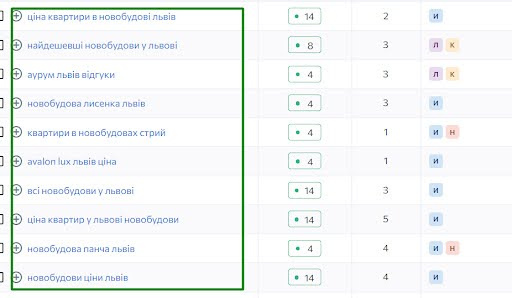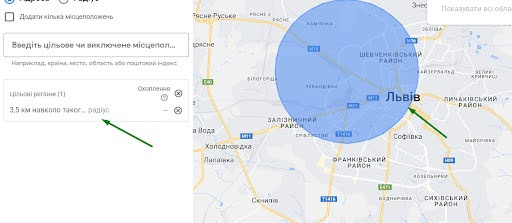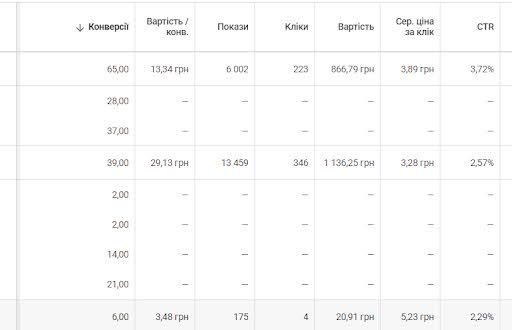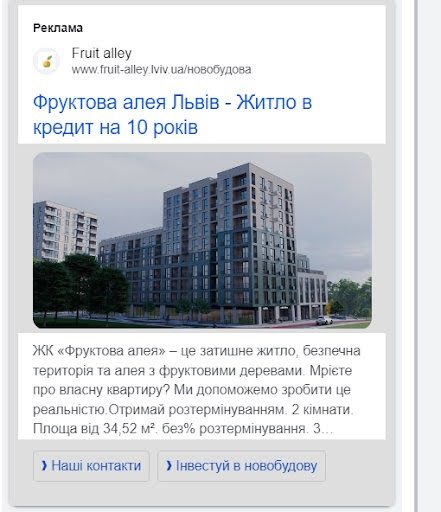10 TOP TIPS ON EFFECTIVE CONTEXTUAL ADVERTISING
1. LOOK AT YOUR COMPETITORS
Before setting up your advertising campaign, it’s always worth analyzing your competitors’ advertising strategies. Make sure you pay attention to the following aspects:
- paid traffic coming from contextual advertising
- share of paid traffic in total traffic
- priority advertising channels
- targeted keywords
- ad copies
- targeted locations
This information is necessary to assess the scale of competitors’ advertising activity, territorial coverage, budget, and key unique selling points.


2. COLLECT AND ORGANIZE SEMANTICS CONSIDERING THE REAL ESTATE SPECIFICS
The choice of keywords to target should depend on the specifics of your business. For example, if you’re advertising a specific residential complex, everything is quite simple: you should use branded queries + queries related to the product (types of real estate, district, housing class, etc.). On the other hand, if this is advertising for a real estate agency, a portal, or a large developer offering various types of real estate in different locations, the semantics will be much broader.
When choosing keywords for real estate advertising, make sure you focus on the following search intents:
type of service: sale, rent, exchange;
type of building: : brick, panel, monolith, aerated concrete, etc.
housing class: economy, business, comfort, luxury, elite, etc.
location:: city, district, closest subway station, street, closest landmark, etc.
additional options: car park, park, river, elevator, number of floors, etc.
number of bedrooms: one-bedroom, studio, two-bedroom, etc.
name of the residential complex, developer, agency: eviews, progress of construction, etc.
type of real estate: first sale, resale, offered by the developer
type of space:layout, area, ceiling height, etc.

3. LEVERAGE HYPERLOCAL TARGETING
Hyperlocal targeting refers to targeting customers in a highly specific, geographically restricted area, sometimes even a building.
Google Ads offers limited possibilities for hyperlocal targeting: as a minimum, you can reach the audience within a circle with a radius of 500 m. In conditions of dense urban development, such a radius doesn’t allow you to target, let’s say, only the visitors of a specific building.

Here are some ideas for choosing locations for hyperlocal targeting:
- arget your competitors’ sales offices. This way, you’ll get access to the audience actively looking for real estate.
- If you sell elite or business class real estate, target establishments visited by audiences with corresponding income levels, such as elite country clubs, yacht clubs, golf clubs, expensive restaurants, etc.
- Target locations next to billboards with your advertising. This will let you reach people who have likely seen your offline ads.
4. MAKE A UNIQUE OFFER
Most real estate ads look quite similar: a specific apartment, a residential complex, or real estate sale/rent services are offered. Given that, it makes sense to work on a unique selling point that will let your ads stand out from others.


5. IF YOU HAVE A LIMITED BUDGET, FOCUS ON DISCOVERY ADVERTISING



From our experience, this type of advertising is the most effective for real estate. The main thing is to create the right audiences to target.
6. GET USERS BACK WITH THE HELP OF REMARKETING
Remarketing is a universal technique suitable for most niches. Remarketing works especially well for businesses with a long sales cycle, such as real estate: users consider options for a long time before making a final choice. After visiting your site for the first time, many people will leave without completing a transaction. Your task is to remind them of yourself and bring them back. This is precisely where remarketing can help.
For example, here are Google remarketing campaigns that best suit the real estate niche:
- Display remarketing:. users see your ads if they belong to remarketing audiences (for instance, they completed a specific series of actions on your website, visited certain pages, etc.)
- Dynamic remarketing:. this option helps target users who have already viewed specific products: apartments, premises, houses, etc. The ads are automatically created taking into account the features of the previously viewed products.

7. EXTEND YOUR REACH: TARGET OTHER BRANDS
This approach works for advertising developers and residential complexes that are geographically close to the developer or residential complex whose brand is being targeted. In addition, it is important to target brands that sell real estate in a price range similar to yours.

Advantages of targeting competitor brands
- you are guaranteed to reach the audience looking for real estate
- you raise your brand awareness, especially when targeting well-known brands
When targeting competitor brands, remember these rules:
- advertising systems prohibit including the names of registered trademarks in the ads of advertisers who don’t own these brands
- you mustn’t include information that can harm the reputation of the targeted brand
8. TARGET OTHER KEYWORDS RELATED TO REAL ESTATE
This is another way to expand your reach. You can find users who are planning to buy real estate not only using direct queries, but also ones that aren’t directly related to buying/renting real estate, such as mortgages. If a user is interested in mortgage lending, they are very likely considering buying an apartment.
9. MAKE YOUR ADS NOTICEABLE: ADD EXTENSIONS
Extensions are useful for two reasons: on the one hand, they allow you to add more information to the ad and make it more noticeable, and, on the other hand, they improve the ad strength, increasing its ranking on the search results page without raising the bid.

10. EXPERIMENT WITH OTHER CHANNELS
Contextual advertising is only part of the channels for attracting customers in the real estate sector. To understand which channels are most effective in your case, it’s worth testing different options.
CONCLUSION
Real estate advertising is a separate direction for development and growth. It is necessary to examine the audience, demand, and relevance of your offerings. Identify your competitors and use their strengths to your advantage, keeping your finger on the pulse of changes and experiments.
- Demand for real estate mostly depends on the price. Autumn is an active phase for businesses, as they move from one region to another, and new ones are launched. At the same time, the price for real estate rises, which is pretty logical.
- Demand for real estate mostly depends on the price. Autumn is an active phase for businesses, as they move from one region to another, and new ones are launched. At the same time, the price for real estate rises, which is pretty logical.